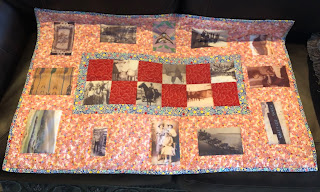#43 Transportation. 52 Ancestors In a Year
Prairie Schooner was a hard way to travel.
My mother’s family traveled west on the Oregon Trail. My great great great grandfather, John Lloyd, headed west in 1845 with 2 wagons and 10 family members. My mother was able to obtain the letters he wrote back to his brother in Tennessee so we have a glimpse of the trip.
I marvel at John Lloyd who left a farm in Missouri wonder what made him want to endure the months of hardship traveling to Oregon? I often wonder what his wife said when he told her of his plans. In order to make the trip, there was wagons and oxen to obtain, food to stock the wagons and decisions to be made of what to take west in limited wagon space. In the research it seems that many from the same area were going. There were meetings of planning, organization and developing rules to follow. Deadlines for the wagons to meet before leaving, inspections of supplies, firearms and riders to organize to move the cattle. Before they left, John wrote to his brother telling him to be sure and write them in Oregon and have the letters in St. Joe by March of each year. They left Missouri knowing that they might never see family again. They left a daughter and her family assuming that they would come west the next year. But she never did.
Dad examines a diorama at The Archway in Kearney, Nebraska
I had passed under this museum, The Archway, numerous times but never took the time to stop. One day on a trip home from Kansas in 2002, Dad & I stoped. It was so worth the time and money. Dad was always curious how they hooked up the oxen; he was able to learn!
If you ever under The Arch, on I-80; take a few minutes & enjoy the tour.
My great great grandmother, Lois Jasper, was 13 when she left Missouri for Oregon. Her father had died in 1845 and her older brothers and a sister had gone west. One brother returned for his widowed mother, 5 siblings and an old maid aunt and took them to Oregon. It was always said that Lois walked most of the way. How did they finance the trip? It wasn’t cheap to buy wagons, oxen and supplies.
Lois's mother, Polly Heath Jasper, carried this tin in her pocket.
I have traveled much of the trail and am constantly amazed at trip undertaken in the prairie schooner.
How did they pull those wagons through the rocks around Scottsbluff?
As you traverse the trail, especially through Wyoming, I wonder, how did they do it??? There are place on the trail that I am sure you can see where you will be camping at night, from the morning when you broke camp! And in the horizon were huge mountains. Did they wonder & worry how they would cross?
Of course the pioneers walked. The wagons were rough riding as well as it was necessary to lighten the load. I wonder how many walked barefoot? There were not many shoe stores along the trail!
Food and water on the trail were also an issue. There are miles and miles where water wasn’t readily available. And bad water was the cause of many deaths. It was most important to water & feed the livestock first.
And after you have been on the trail for months, when someone tells you they know a shorter and better way, what do you do? Taking that advice led to a lot of problems for John Lloyd as he traveled the Meek Cutoff Trail in Oregon.
The hard daily work of the people in the wagon train simply amazes me. The wagons rolled out by 8 AM (information from a journal), so that meant breakfast must be prepared and served and dishes cleaned up. Perhaps they had food from the night before, but otherwise a fire would have had to be built. The process was repeated in the evening. In the evening horses, mules and oxen also had to be fed. How did they pack enough water? How did they do laundry? Or did they? Women gave birth along the trail, maybe the wagon train held up for a day; maybe not. If someone was sick; they often were left behind.
Women wore Sunbonnets to protect their face.
The sun, the dirt. Imagine trailing about 100 head of cattle along with the wagon train, plus horses and oxen. I can see the dust!
There was constant worry about Indians too. One of my great great grandmother’s sister’s wrote of the Indian bothering them; but luckily nothing happened to either wagon train.
Can you imagine rationing out your supplies of food so that you can survive to the end? One letter John wrote to his brother said that they didn’t run out of flour or bacon but many in the train had. Were there stores along the way to supply the wagons. There were occasional forts and supply houses; but not many.
Can you imagine the hard work that everyone did? I can't.
The dairies tell of the hardship the women faced daily.
There are numerous stories of how they roped wagons down steep hills, broke down the wagons to float across a river, the brut strength of women pushing the wagons up the hill, the brut strength of the men handling the oxen, repairing the wagons and helping each other. I know all those stories, but I still wonder--how did they do it??? Day after day for 6 months...could you do it??
When we think we have it tough, I think of my ancestors on the Oregon Trail and realize life is pretty good. Even waiting at the airport for a few hours isn't that hard!
































